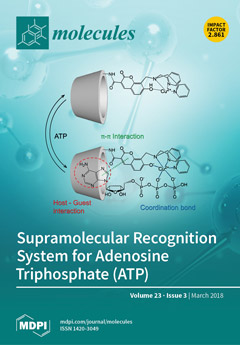Open AccessArticle
Structure-Based Discovery of a Series of 5H-Pyrrolo[2,3-b]pyrazine FGFR Kinase Inhibitors
by
Alan Jiang 1,2,†, Qiufeng Liu 3,†, Ruifeng Wang 4,5,†, Peng Wei 4,5, Yang Dai 2, Xin Wang 5, Yechun Xu 3,*, Yuchi Ma 5,*, Jing Ai 2,*, Jingkang Shen 5, Jian Ding 1,2 and Bing Xiong 5,*
1
College of Pharmacy, Nanchang University, 461 Bayi Avenue, Nanchang 330006, China
2
Division of Anti-Tumor Pharmacology, State Key Laboratory of Drug Research, Shanghai Institute of MateriaMedica, Chinese Academy of Sciences, 555 Zuchongzhi Road, Shanghai 201203, China
3
Drug Design and Discovery Center, Shanghai Institute of Materia Medica, Chinese Academy of Sciences, 555 Zuchongzhi Road, Shanghai 201203, China
4
Key Laboratory of Structure-Based Drug Design and Discovery of Ministry of Education, Shenyang Pharmaceutical University, Shenyang 110016, China
5
Department of Medicinal Chemistry, Shanghai Institute of Materia Medica, Chinese Academy of Sciences, 555 Zuchongzhi Road, Shanghai 201203, China
†
These authors contributed equally.
Cited by 12 | Viewed by 5993
Abstract
Fibroblast growth factor receptors (FGFRs), a subfamily of receptor tyrosine kinases, are aberrant in various cancer types, and considered to be promising targets for cancer therapy. We started with a weak-active compound that was identified from our internal hepatocyte growth factor receptor (also
[...] Read more.
Fibroblast growth factor receptors (FGFRs), a subfamily of receptor tyrosine kinases, are aberrant in various cancer types, and considered to be promising targets for cancer therapy. We started with a weak-active compound that was identified from our internal hepatocyte growth factor receptor (also called c-Met) inhibitor project, and optimized it with the guidance of a co-crystal structure of compound 8 with FGFR1. Through rational design, synthesis, and the biological evaluation of a series of 5
H-pyrrolo[2,3-
b]pyrazine derivatives, we discovered several potent FGFR kinase inhibitors. Among them, compound 13 displayed high selectivity and favorable metabolic properties, demonstrating a promising lead for further development.
Full article
►▼
Show Figures






